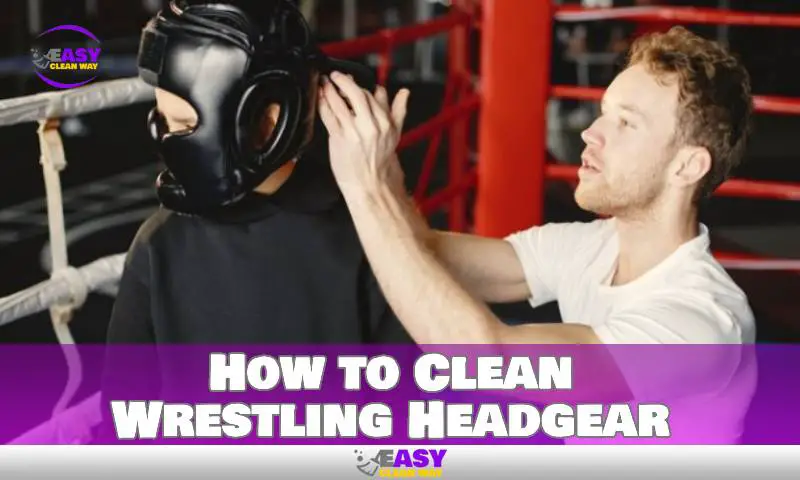To clean wrestling headgear, first, remove any surface dirt and sweat with a damp cloth, then use a mixture of mild soap and water to gently scrub the headgear. Rinse thoroughly and allow it to air dry completely before using it again.
Properly maintaining and cleaning wrestling headgear is crucial for the health and safety of wrestlers. After intense training sessions or matches, headgear can accumulate sweat, dirt, and bacteria, which can lead to skin infections. To prevent this, it is essential to know how to clean wrestling headgear effectively.
In this guide, we will provide you with a step-by-step process to ensure your headgear stays clean and free from harmful bacteria. By following these simple guidelines, you can keep your headgear in top condition and prolong its lifespan while also keeping yourself safe from potential skin issues. So let’s dive into the proper cleaning techniques for wrestling headgear.
Understanding The Importance Of Cleaning Wrestling Headgear
Wrestling headgear is an essential piece of equipment that helps protect wrestlers from potential head injuries during matches and practices. However, many athletes overlook the importance of regularly cleaning their headgear, which can have detrimental effects on both performance and health.
Here, we will delve into the role of hygiene in wrestling and the impact of unclean headgear on overall well-being.
The Role Of Hygiene In Wrestling
Maintaining proper hygiene in the sport of wrestling is crucial for several reasons. Here are the key points to remember:
- Preventing the spread of bacteria and infections: Wrestling involves close contact with opponents and sweating, making it a breeding ground for bacteria and infections. Regularly cleaning headgear helps minimize the risk of spreading harmful microorganisms.
- Promoting a healthy training environment: A clean training environment is essential for athletes to perform at their best. By keeping headgear clean, wrestlers can ensure a hygienic space for themselves and their teammates.
- Maintaining personal hygiene: Much like regular showers and clean uniforms, cleaning headgear is part of personal hygiene for wrestlers. It helps prevent odors and keeps the equipment in good condition.
The Impact Of Unclean Headgear On Performance And Health
Neglecting to clean wrestling headgear can have negative consequences for both performance and overall health. Here are the key points to consider:
- Reduced performance: Unclean headgear can accumulate sweat, dirt, and oils over time. This buildup can impair the fit and comfort of the gear, leading to distractions and discomfort during matches or practices.
- Skin irritations and infections: Bacteria and fungi thrive in unclean environments. By neglecting to clean headgear, wrestlers increase their risk of developing skin irritations, such as rashes, or contracting infections like ringworm.
- Unpleasant odors: The accumulation of sweat and bacteria in unclean headgear often leads to foul odors. Not only can this be embarrassing for wrestlers, but it also affects the overall training environment.
- Decreased lifespan of equipment: Properly cleaning and maintaining headgear can extend its lifespan. Neglecting this essential step may result in gear deteriorating more quickly, leading to increased replacement costs.
It is crucial for wrestlers to understand the importance of regularly cleaning their headgear to maintain hygiene, prevent health issues, and optimize their performance on the mat. By incorporating proper cleaning practices into their routine, wrestlers can ensure safer and more enjoyable wrestling experiences.
Before You Begin: Preparing For Cleaning

Before you begin cleaning your wrestling headgear, it’s important to gather all the necessary cleaning materials. Having everything ready will make the cleaning process quick and efficient. Here are the key points to keep in mind:
- Mild soap or detergent: Choose a soap that is suitable for delicate fabrics and will not damage the material of your headgear.
- Warm water: Fill a basin or sink with warm water to use for soaking and rinsing the headgear.
- Soft-bristle brush: A soft brush will help remove any dirt or debris stuck on the headgear without causing damage.
- Towels or drying rack: Prepare some towels or use a drying rack to lay the headgear flat and allow it to dry after cleaning.
- Disinfectant spray: It’s a good idea to have a disinfectant spray on hand to kill any bacteria or germs that may be present.
- Zippered mesh laundry bag: Using a zippered mesh bag will help protect the headgear during the washing machine cycle if you choose to clean it that way.
- Optional: White vinegar: If your headgear has a persistent odor, adding a small amount of white vinegar to the water can help remove the smell.
Now that you have gathered all the necessary cleaning materials, you can move on to the next step: disassembling the wrestling headgear.
Step-By-Step Guide To Cleaning Wrestling Headgear
Wrestling headgear is an essential piece of equipment for any wrestler. Not only does it protect the ears from injuries, but it also keeps hair out of the face during high-intensity matches. However, over time, dirt, sweat, and bacteria can accumulate on the headgear.
To keep your headgear in top condition, it’s crucial to clean it regularly. Follow this step-by-step guide to ensure that your wrestling headgear stays clean and ready for the next match:
Assessing The Material Of The Headgear:
Before diving into the cleaning process, it’s essential to determine what material your wrestling headgear is made of. Different materials require different cleaning methods to avoid damage. Here are a few common materials used in wrestling headgear:
- Vinyl: is easily cleaned with mild soap and water.
- Fabric-covered foam: requires extra caution to prevent water absorption.
- Molded plastic: is easy to clean and relatively durable.
Handwashing vs Machine Washing: Pros And Cons:
When it comes to cleaning wrestling headgear, you have two options: handwashing or machine washing. Each method has its pros and cons. Consider the following:
Handwashing:
- Pros:
- Allows for greater control over the cleaning process.
- Reduces the risk of damage to fragile materials.
- Cons:
- Requires more time and effort.
Machine washing:
- Pros:
- Convenient and time-saving.
- Suitable for headgear made of durable materials.
- Cons:
- Potential damage to fragile or foam-based headgear.
- May cause deformation.
Using Mild Detergents And Warm Water For Cleaning:
Regardless of the method chosen, it’s essential to use mild detergent and warm water when cleaning wrestling headgear. Harsh chemicals can damage the material and compromise its effectiveness. Here’s how to clean your headgear effectively:
- Fill a sink or basin with warm water.
- Add a small amount of mild detergent and mix well.
- Submerge the headgear and gently agitate it to loosen dirt and sweat.
- Use a soft brush or cloth to scrub away any stubborn stains.
- Rinse the headgear thoroughly with clean, warm water.
Avoiding Harsh Chemicals That May Damage The Headgear:
To preserve the integrity of your wrestling headgear, it’s crucial to avoid using harsh chemicals during the cleaning process. Common household cleaners, bleach, or ammonia-based products can degrade the material, rendering it less effective. Stick to mild detergents and warm water for the best results.
Properly Drying The Headgear To Prevent Mold Or Bacteria Growth:
After cleaning, it’s important to dry the headgear thoroughly to prevent mold or bacteria growth. Here are a few tips to ensure proper drying:
- Gently squeeze excess water from the headgear without twisting or wringing it.
- Place the headgear on a clean, dry towel, and pat it dry.
- Leave the headgear in a well-ventilated area to air dry completely before storing.
Taking Special Care Of Any Attachments Or Padding:
If your wrestling headgear has attachments or padding, it’s crucial to take special care during the cleaning process. Here’s how to ensure they remain in good condition:
- Remove detachable attachments before cleaning.
- Handwash them separately using mild detergent and warm water.
- Gently squeeze out excess water and air dry.
- Avoid using excess force when scrubbing or drying padding to prevent deformation.
Keeping your wrestling headgear clean not only helps extend its lifespan but also ensures optimal performance and hygiene. By following this step-by-step guide, you can confidently clean your headgear and gear up for success on the mat. So, take the time to care for your gear, and it will take care of you during intense wrestling matches.
Tips For Preventing And Removing Odor
Wrestling headgear can accumulate unpleasant odors due to various reasons. The common causes of odor in wrestling headgear are:
- Sweating: Intense physical activity in wrestling leads to excessive sweating, which can result in odor buildup in the headgear.
- Bacteria and fungus: Sweat that remains on the headgear provides a breeding ground for bacteria and fungus, leading to foul smells.
- Moisture retention: Improper drying of the headgear or storing it in a damp environment can promote the growth of odor-causing microorganisms.
- Body oil and dead skin cells: The accumulation of body oil and dead skin cells on the headgear can lead to an unpleasant smell over time.
Every-Use Prevention Methods For Odor Control
Preventing odor from developing in wrestling headgear can be achieved through simple steps in your regular routine. Here are some effective everyday prevention methods for odor control:
- Cleanliness: Ensure that you shower and thoroughly dry your hair before wearing the headgear to minimize the transfer of sweat and oils.
- Regular cleaning: After each use, wipe down the headgear with a damp cloth to remove dirt, sweat, and grime.
- Air drying: Allow the headgear to air dry completely before storing it. This prevents moisture buildup and discourages the growth of bacteria and fungus.
- UV exposure: Harness the power of sunlight by placing the headgear in direct sunlight for a few hours. UV rays help eliminate bacteria and neutralize odors.
Recommended Odor-Removing Products And Techniques
When odors persist despite preventative measures, it’s time to consider odor-removing products and techniques. Here are some recommendations to tackle those stubborn smells:
- White vinegar solution: Create a mixture of equal parts white vinegar and water. Spray or wipe the headgear with this solution to kill bacteria and eliminate odors.
- Odor-neutralizing sprays: Use commercially available sprays specifically designed to neutralize odors. Follow the instructions on the product for best results.
- Baking soda: Sprinkle baking soda liberally on the headgear, allowing it to sit for a few hours or overnight. This natural deodorizer absorbs unpleasant odors.
- Machine washing: Check if your headgear is machine washable. If it is, use a mild detergent on a gentle cycle and air dry afterward. Refer to the manufacturer’s guidelines before attempting this method.
By understanding the common causes of odor, implementing preventative measures, and utilizing suitable odor-removing products and techniques, you can keep your wrestling headgear clean and smelling fresh. Don’t let unwanted odors distract you from your wrestling performance!
Ensuring Longevity And Hygiene Of Wrestling Headgear

Establishing A Regular Cleaning Schedule
Wrestling headgear is an essential piece of equipment that protects a wrestler’s ears and head during matches and practices. To ensure the longevity and hygiene of your wrestling headgear, it is crucial to establish a regular cleaning schedule. Here are some key points to keep in mind:
- Cleaning frequency: Clean your wrestling headgear after every use to remove sweat, dirt, and any bacteria that may have accumulated. This will help prevent the growth of odor-causing bacteria and maintain the gear’s integrity over time.
- Gentle hand washing: It is recommended to hand wash your headgear using mild soap and warm water. Avoid using harsh chemicals or bleach, as they may damage the materials.
- Soaking or wiping: Depending on the specific cleaning recommendations provided by the headgear manufacturer, you may need to either soak your headgear in soapy water for a few minutes or wipe it down with a damp cloth. Check the instructions or contact the manufacturer if you are unsure.
- Thorough drying: After cleaning, make sure to thoroughly dry your headgear before storing it. Moisture can promote the growth of bacteria and mildew, leading to odors and potential damage. Leave it in a well-ventilated area or use a towel to pat it dry.
Proper Storage And Maintenance Of Headgear
Proper storage and maintenance are equally important in ensuring the longevity and hygiene of wrestling headgear. Consider the following points:
- Suitable storage: Store your headgear in a clean, dry, and well-ventilated area. Avoid storing it in damp places like gym bags or lockers, as moisture can lead to mold and mildew growth.
- Air circulation: Allow your headgear to air out after cleaning and before storing it. This helps prevent moisture buildup and allows any remaining dampness to evaporate.
- Avoid sun exposure: Prolonged exposure to direct sunlight can cause the headgear materials to fade, degrade, or warp over time. Store your headgear away from direct sunlight.
- Elastics and straps: Check the elastics and straps of your headgear regularly for any signs of wear or damage. Replace them if they become stretched out, frayed, or lose their elasticity.
- Clean storage container: If you use a storage container for your headgear, make sure it is clean and dry before placing the gear inside. Regularly clean the container to prevent the growth of bacteria.
Inspecting For Damage And Regular Replacement
Regularly inspecting your wrestling headgear for damage and knowing when to replace it is crucial for safety and hygiene. Consider the following points:
- Visual inspection: Inspect your headgear visually before and after each use. Look for any cracks, tears, or deformities in the materials. Pay attention to loose stitching or any parts that appear worn out.
- Odor control: Even with proper cleaning, headgear can develop persistent odors. If, despite your efforts, the gear continues to smell foul, it may be time for a replacement.
- Replace when necessary: It is recommended to replace your headgear every one to two years, depending on usage and wear. If you notice any significant damage or your headgear no longer fits securely, it’s time for a new one.
- Manufacturer’s guidelines: Different headgear brands and models have varying lifespans and cleaning recommendations. Always refer to the manufacturer’s guidelines for specific maintenance and replacement instructions.
By establishing a regular cleaning schedule, storing your headgear properly, and inspecting it for damage on a regular basis, you can maintain the longevity and hygiene of your wrestling headgear. Remember to follow the manufacturer’s instructions and prioritize safety and cleanliness to maximize your gear’s performance and protect yourself during matches and practices.
FAQ
How Do You Clean Wrestling Headgear?
To clean wrestling headgear, soak it in warm soapy water, scrub gently, rinse thoroughly, and air dry.
Can You Machine Wash Wrestling Headgear?
Machine-washing wrestling headgear is not recommended as it can damage the material and affect its performance.
How Often Should I Clean My Wrestling Headgear?
To maintain hygiene, clean your wrestling headgear after every use to remove sweat, dirt, and bacteria.
Can I Use Bleach To Clean My Headgear?
Avoid using bleach on your wrestling headgear, as it can cause discoloration and damage to the material.
Conclusion
To ensure your wrestling headgear lasts and maintains its quality, it is crucial to regularly clean and care for it. By following the steps outlined in this blog post, you can effectively clean your wrestling headgear and eliminate any buildup of sweat, bacteria, and odor.
Start by inspecting your headgear for any damage, and then proceed to remove any removable padding or straps. Use a mild detergent and lukewarm water to gently clean the headgear, making sure to avoid harsh chemicals that may deteriorate the material.
After washing, allow the headgear to air dry completely before storing it in a clean and dry place. Remember, frequent cleaning not only ensures hygiene but also prolongs the lifespan of your wrestling headgear, saving you money in the long run.
So, make this cleaning routine a regular part of your wrestling gear maintenance to keep your headgear in top-notch condition and maximize your performance on the mat.
Hey there! I’m Alton Smith, your Clean Expert blogger. I’m on a quest to help you conquer chaos and embrace the joys of a tidy life.





